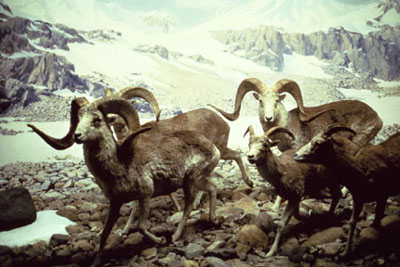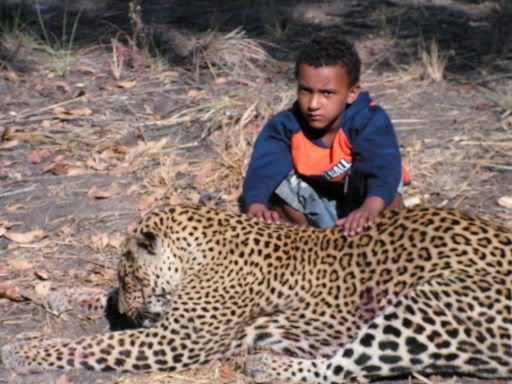

 The Accurate Reloading Forums
The Accurate Reloading Forums  THE ACCURATE RELOADING.COM FORUMS
THE ACCURATE RELOADING.COM FORUMS  Hunting
Hunting  Asian Hunting Forum
Asian Hunting Forum  A different battle for survival goes on in Kashmir foothills
A different battle for survival goes on in Kashmir foothillsGo  | New  | Find  | Notify  | Tools  | Reply  |  |
| one of us |
Khaleej Times Online >> News >> SUBCONTINENT A different battle for survival goes on in Kashmir foothills By M.H. Wani (Our correspondent) 25 February 2008 SRINAGAR — A ragging survival battle for food and shelter between the man and the beast has so far consumed 150 people. And a thousand injured in beastly attacks live a life of cripples. Instances of leopards being mowed down after killing nine and even 18 humans in last few years do exist in this part of the world. "Incidences of man-predator conflict are increasing," says Rashid Naqash, who manages Kashmir's main Dachigam National Park in Srinagar outskirts. "It is an issue that is on top of our concern." Now, the government has evolved a relief package — Rs100,000 for a death and Rs33,000 in case of severe injury — the same scale as applies to turmoil's collateral damage envisaging over 42,000 souls among other losses in two decades. With black bear playing second fiddle, it is the leopard at the apex of the wild food pyramid here. Unlike the bear that goes to hibernation during winter, leopard is round the year threat. Experts attribute lot of factors to the 'emerging trend'. Seizure of hunting guns during amorphous years of militancy and the fear of getting caught in the crossfire between militants and troops kept poachers and hunters off the forests. A subsequent blanket ban on hunting has triggered an imbalanced growth pattern in both predators and the preys. Hangul, Kashmir's critically endangered red deer, whose number has dwindled from over 5,000 to barely 152 in last one century for a multitude of reasons, is the best instance explaining the trend. A three year study in Dachigam confirmed the alarming fall in deer's fawn-female ratio as black bear breaks winter hibernation by consuming new born fawns. Deer was found to be making over 60 per cent of leopard food. Now, says Naqash, they would use two satellite and four GPS collars to study the deer for evolving adequate conservation majors to prevent it from extinction. A Rs860 million plan on the pattern of Project Tiger — envisaging resuming captive breeding — stands submitted to the federal government for funding, said A.K. Srivastava, state's chief wildlife warden. But the predator prey base, now, includes humans. Biotic interference, human intervention and shrinking habitat are factors behind the conflict. Abandoned culled fruit around hills are a delicacy for the fat-hunting bear and proves bear traps for people in autumn. But that is just one side of the grim picture. Security situation has immensely contributed to the entire crisis. Emergence of garrisons (even Dachigam has one deep inside), militant hideouts and massive movement deep into woods on long term basis has disturbed the wildlife. Says Abdul Rashid Wani, former principal conservator of forests: "We would never know how many leopards got killed by straying into minefields on either side of the Line of Control (LoC)," a de facto border dividing Kashmir between India and Pakistan. The Siamese twins of the subcontinent are not signatories to the landmine ban treaty prohibiting use, production, stockpiling and transfer of antipersonnel mines and the Kashmir 'border' has vast minefields on either side, some of them as old as partition. Unlike humans, animals do not recognise border. But when there are physical obstacles like fences, it limits their cruising range forcing them to react by creating alternative ranges that in most of the cases impacts human settlements. Apparently to stop infiltration of armed militants from the Pakistan administered Kashmir, India invested heavily in creating an engineering feat. Two parallel lines of 12-feet high fences snakes around the zigzag LoC for most of over 742kms. In between is an eight-foot gap stuffed with coils of razor-sharp concertina wire and sophisticated American and Israeli thermal imagers and sensors that alarms border guards if it is fiddled with. "When you limit the cruising range, the animal moves out of its ecological niche as a result of which it either fall in conflict with humans or die of stress," insists Wani. Many wildlife experts think the easy food in the form of corpses that lay scattered along the LoC — where hundreds of encounters between troops and infiltrating insurgents left so many bodies' un-retrieved — turned leopards into man-eaters. "Once a leopard tastes human flesh, it gets addicted and then there is no stopping," one senior official in the wildlife department said wishing to remain anonymous. But conservation of wildlife is not costing human bodies alone. It has devoured two major economies of Kashmir. The famed ring shawl made of Shahtus is banned globally because the Chiru whose fleece goes into the making of costliest shroud on earth is critically endangered in the Tibetan plateau. Ban on fur followed the halt to hunting. This fall, Kashmir witnessed the start of consigning to flames a registered stock of 840,000 animal skins and hides involving over three million animals publicly. Srivastava put its value at Rs900 million. Though the government would compensate 224 traders and over 500 artisans for the loss, it has washed its hands off from helping the impacted lot in finding alternative sources of sustenance. Remedy to the mess may need capital intensive changes. A study carried out by state's wildlife department with Wildlife Trust of India, Ecollage and CI-CABS suggested after probing 230 encounters suggested creating electric fences as artificial barrier besides changing crop pattern near forest belts and better management of waste material on priority. Kathi kathi@wildtravel.net 708-425-3552 "The world is a book, and those who do not travel read only one page." | ||
|
| One of Us |
In the 1920's, Jim Corbett blamed the epidemic fatal illness (flu)-- which caused so many deaths that the bodies were left outside and not cremated as usual-- as the reason leopards and some tigers had become used to eating man-flesh and thereby became mankillers. Sounds like an analogous situation is going on presently. Corbett's tale of his hunt for the maneating leopard of Rudraprayag is absolutely one of the greatest hunting tales of all-time. Indian boy with leopard, Tanzania '06  Steve "He wins the most, who honour saves. Success is not the test." Ryan "Those who vote decide nothing. Those who count the vote decide everything." Stalin Tanzania 06 Argentina08 Argentina Australia06 Argentina 07 Namibia Arnhemland10 Belize2011 Moz04 Moz 09 | |||
|
| Powered by Social Strata |
| Please Wait. Your request is being processed... |
|
 The Accurate Reloading Forums
The Accurate Reloading Forums  THE ACCURATE RELOADING.COM FORUMS
THE ACCURATE RELOADING.COM FORUMS  Hunting
Hunting  Asian Hunting Forum
Asian Hunting Forum  A different battle for survival goes on in Kashmir foothills
A different battle for survival goes on in Kashmir foothills

Visit our on-line store for AR Memorabilia

